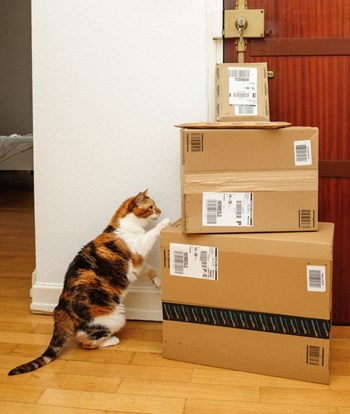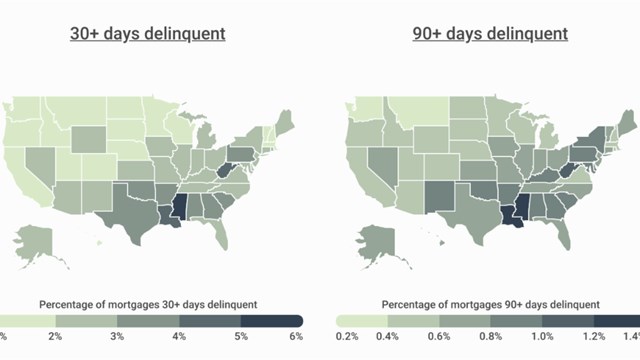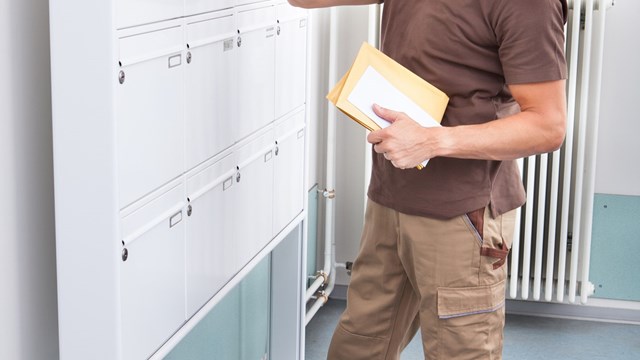
While there are strong arguments to be made about the less-than-great impact the internet has had on our lives and the world, few would disagree that it's made a lot of things a whole lot more accessible to a lot more people -- especially at the moment, when the coronavirus pandemic has made regular brick-and-mortar shopping inconvenient at best, impossible or dangerous at worst. Even before municipal lockdowns and shelter-in-place orders were issued, practically anything, from sushi to sports equipment to sofas, could be delivered right to your door – often within 24 hours of ordering it. Convenience on a level once reserved for very wealthy people with household staff they could send out to pick up whatever is now taken for granted by nearly everyone, regardless of tax bracket.
In many multifamily buildings however, the result of this convenience is anything but. Doormen and frontline building staff are regularly buried in everything from clothing to books to electronics to groceries, and residents in unstaffed buildings worry about packages left unattended in vestibules or lobbies. The piles were getting bigger even before COVID-19 put the whole process into overdrive (and added the additional element of worry over the virus spreading through contact with boxes and other packaging). So what’s the solution? In a word: organization.
Making Room for More
“Storage needs for package delivery have changed over the years,” says Susan Lauren, the principal of New York-based Lauren Interior Design. “What was appropriate 10 years ago is no longer sufficient for most buildings. The space set aside just isn’t large enough. Very often we are building out package closets into existing lobby space, or adding storage capacity by creating furniture like storage cabinets that are customized to the space and match the décor and design of the lobby.”
In addition to the avalanche of boxes arriving each day from Amazon, other regular delivery items – things like dry cleaning and registered mail – are still being dropped off, and still take up plenty of space. In many cases, those items compete for space with online retail deliveries, including perishable food from meal-kit purveyors like Fresh Direct and Blue Apron, which may also require refrigeration, adding a whole new dimension to the bottleneck.
When designing a new or upgraded storage space and box reception area for a multifamily client, Lauren speaks with the concierge and doorman to get their input on how much more space they think they need, and what kind – shelves versus hanging bars, for example – since they're the ones coping with the problem daily. “I let them drive the direction of the size and objective of the new or redesigned space,” she says.
At one client building, Lauren redesigned an existing storage area, increasing the space by approximately 50%. The plan included the relocation of the attendant's desk to position it in front of the planned updated storage area. According to Lauren, keeping the attendant’s station close to the storage area is a priority in planning storage space, since neither the residents nor the doormen or concierge want to abandon the security station to fetch packages.
What If There’s No Doorman?
Neil Golub, director of sales for Carson Living, Inc., a New York-based firm that provides resident services for smaller and non-doorman apartment buildings, explains that there are options for all types of properties, even those without staff. “For older buildings,” he says, “we deal with some space challenges. For small walk-up properties we suggest a very cutting-edge turnkey solution. We create a cage with controlled access and an electrified lock which is integrated with Carson’s systems. We can automatically open it when there is a delivery.”
Because of those space limitations, Golub says these units are compact and efficient; they can be located under a stairwell, for instance. Once the units are installed and operational, delivery people use a communications pad at the front door to request access. Carson provides entrance to the building, instructs them where to drop the package, and provides access to the storage cabinet. The company then confirms with the package recipient via email, text, or app notification that a package has been delivered.
The COVID Factor
When the novel coronavirus first gained a foothold in the US in February 2020, concerns over how exactly the virus was transmitted extended to the possibility of people picking up the infection from surfaces -- including envelopes, boxes, and other mail packaging. While concerns over how long coronavirus can survive on cardboard, plastic, or other materials have been somewhat calmed as more information has become known about how it does (and does not) behave, an abundance of caution is still likely the best way to operate in order to keep both building staff and residents as safe as possible.
For its part, the Centers for Disease Control and Prevention (CDC) does not explicitly recommend disinfecting packages, but rather advises anyone in contact with so-called ‘high touch’ surfaces to wash their hands frequently, and to minimize interpersonal contact as much as possible. According to guidelines on the cdc.gov, “It may be possible that a person can get COVID-19 by touching a surface or object that has the virus on it and then touching their own mouth, nose, or possibly their eyes, but this is not thought to be the main way the virus spreads.”
The Occupational Safety and Health Administration (OSHA) has taken a similar position, advising both package handlers and recipients to wash their hands after coming in contact with packaging, and suggesting that recipients in higher-risk groups -- such as older people, those with immune system compromises, and other vulnerabilities -- dispose of outer packaging outside of their homes if possible, though the Center does note that “this is likely not necessary for most people’s handling of most cardboard packages.”
The CDC also notes that “on the way to picking up your package, you may be touching a number of things that qualify as ‘frequently touched surfaces,’ such as an elevator button...the shared doorknob on the front door, or the stylus that you use to sign for a package. Being aware of your contact with these surfaces is just as important—and maybe more important—than the way you handle packages. Washing your hands will help reduce the risk of infection from surfaces like doorknobs, too.”
Staff Safety
Clearly, doorpersons and concierges are on the front line when it comes to managing the ever-increasing volume of packages arriving daily at our buildings. The New Jersey Cooperator was able to speak with a concierge at a condominium building about how they handle the avalanche. (Both the concierge and the building’s board and management requested anonymity out of consideration for residents' privacy.)
This concierge has been with the building for over 20 years, and reports – consistent with the observations of several other management and building operations professionals – that the sheer number of packages is overwhelming. The professionals estimate that there has been a 60 to 70% increase in boxes and other types of deliveries to the buildings they serve over the last decade. One particularly cumbersome variety they're seeing more and more frequently is large boxes containing furniture meant to be assembled by the purchaser. Furniture is rarely delivered fully assembled to a waiting resident anymore.
Because the existing storage area in the concierge's building is just too small to handle this type of delivery, “We often have to store large box deliveries like these in the emergency fire hallway in the rear of the building,” says the concierge. “Obviously, that’s a fire hazard and a violation. We try to move them out and to the resident’s apartment as quickly as possible.”
And Amazon – that titan of convenience that has become something of a lifeline during the pandemic – is the main driver of the package tsunami, explains our concierge. And it's not just the deliveries coming in that are complicating things; many online retailers accept free returns of merchandise as well – which means that building staff members deal with items both coming and going. Up til now, the holiday season was the toughest time of year, but with the arrival of COVID-19, all bets were off.
On top of box delivery, the concierge says that their front desk also handles traditional dry-cleaning pick-up and drop-off – which adds the dimension of dirty clothing to the mix – as well as deliveries from restaurants and food markets. The building has a refrigerator for cold storage, but that refrigerator has a limited capacity. With all of these challenges, the building staff tries to maintain as much order as possible, but the volume can get overwhelming when residents aren’t immediately available to pick up their deliveries. (For reasons of security and privacy, they prefer not to enter a resident’s apartment when the resident isn’t there.) One interesting point our concierge shared with us is that when Fresh Direct first began deliveries, residents in his building ordered more items more frequently from that particular grocery retailer than they do now. Whether the tapering of that particular delivery service is due to competition from other companies, passing fashion, or some other reason is beyond the scope of this story, but has been interesting to observe from the building staff side of the equation.
Concierge Wish List
So what does the perfect package and storage room look like? We asked a few residential front desk staffers what would make their jobs easier and their work spaces less cluttered and chaotic. According to one concierge, his ideal package room would be situated right behind his station, so he doesn’t have to leave the desk and his responsibilities there to stow or retrieve packages. He’d like to have separate areas for boxes and for dirty laundry, and a relay rack for organizing dry cleaning. Another staffer recommends designating a separate area for package returns with a space where he can work on repackaging if necessary. For groceries, he’d like to see adequate refrigeration that is separated from non-food items in case of spills or other accidents. The ideal solution would include a space with defined compartments to segregate the various functions safely and efficiently.
On the subject of refrigeration, Lauren offers the following advice: “Generally, a full-size refrigerator with a freezer is sufficient for a building with around 100 residents,” meaning that there’s no need for industrial-size kitchen equipment. It’s expensive, takes up a lot of space, and—unless your 200-unit condo is 90% professional chef-occupied—likely redundant.
In the final analysis, managing high volumes of packages and other front-desk business is likely with us for good. Boards and managers are well advised to consider getting ahead of the problem and planning for their future package space needs now. The key is: ask your doorman or concierge; they know what they need.
A J Sidransky is a staff writer/reporter for The New Jersey Cooperator, and a published novelist.









Leave a Comment